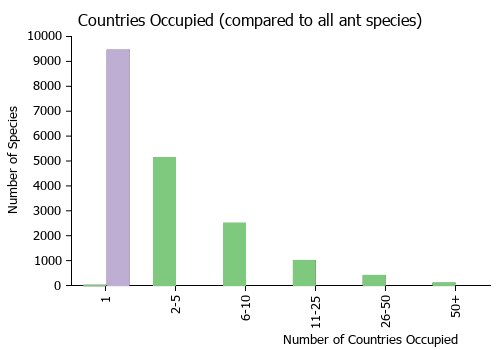Camponotus afflatus
| Camponotus afflatus | |
|---|---|

| |
| Scientific classification | |
| Kingdom: | Animalia |
| Phylum: | Arthropoda |
| Class: | Insecta |
| Order: | Hymenoptera |
| Family: | Formicidae |
| Subfamily: | Formicinae |
| Tribe: | Camponotini |
| Genus: | Camponotus |
| Species: | C. afflatus |
| Binomial name | |
| Camponotus afflatus Viehmeyer, 1925 | |
Identification
Keys including this Species
Distribution
Latitudinal Distribution Pattern
Latitudinal Range: -33.36416° to -33.66583°.
| North Temperate |
North Subtropical |
Tropical | South Subtropical |
South Temperate |
- Source: AntMaps
Distribution based on Regional Taxon Lists
Australasian Region: Australia (type locality).
Distribution based on AntMaps
Distribution based on AntWeb specimens
Check data from AntWeb
Countries Occupied
| Number of countries occupied by this species based on AntWiki Regional Taxon Lists. In general, fewer countries occupied indicates a narrower range, while more countries indicates a more widespread species. |

|
Estimated Abundance
| Relative abundance based on number of AntMaps records per species (this species within the purple bar). Fewer records (to the left) indicates a less abundant/encountered species while more records (to the right) indicates more abundant/encountered species. |

|
Biology
Castes

| |
| . | |
Nomenclature
The following information is derived from Barry Bolton's Online Catalogue of the Ants of the World.
- afflatus. Camponotus (Myrmosaga) afflatus Viehmeyer, 1925b: 140 (w.) AUSTRALIA (South Australia).
- Status as species: Taylor & Brown, 1985: 110; Taylor, 1987a: 11; Bolton, 1995b: 84; McArthur, 2007a: 316; McArthur, 2010: 38; McArthur, 2014: 98.
Type Material
- Camponotus (Myrmosaga) afflatus Viehmeyer, 1925: Syntype, 1 worker, Killalpaninna (as Killalpaninno), South Australia, Australia, Berlin Museum für Naturkunde der Humboldt-Universität.
Unless otherwise noted the text for the remainder of this section is reported from the publication that includes the original description.
Description
Worker media. Head distinctly longer than wide, with almost parallel, forward narrowing sides, rounded posterior corners and convex posterior border. The clypeus has strongly diverging sides, with only a weak short keel behind, on both sides sloping and at the front straight, the center of the lobe is crenulated. The eyes are moderately domed, with their back edge an eye lengths distant from the posterior corners of the head, their front edge behind the middle of the head. Frontal area is indistinct, only beyond the clypeus sharp and roundly edged. Mandibles with weakly curved outer edges, 6 teeth. Antennae lacking. The thorax in profile somewhat similar to erythropus, but the pronotum is shorter, sides not so distinctly curved, its greatest breadth is at the front (with erythropus it is in the middle), pronotal suture weak (erythropus it is strong), convex, no trace of a mesoepinotal suture or of a bordered metanotum. Epinotal (= propodeal?) impression longer and somewhat deeper. Epinotal angle more open rounded, the thorax in its whole distance from right to left is more strongly convex, the pronotum rounded only to the front (in the case of erythropus in front and also the side) Node narrower and lower, forming a column above scarcely diminished and almost level.The whole body finely reticulate and glossy, Mandibles smooth with coarse punctations, also on the front part of the head, sparse and much weaker; The gaster thickly and finely punctated. On the dorsal face of the tibia there is a distinct single row of spines, on the ventral face one row of spines. Upstanding covering of hairs quite scattered, yellowish white; flat lying on the head and limbs scattered and very shot, on the thorax and gaster forming a bluish dark green circlet. Chocolate brown, the gaster dark brown the segments ringed with yellow.
Killalpaninna, South Auistralia. W.Rielel.
References
- Bolton, B. 1995b. A new general catalogue of the ants of the world. Cambridge, Mass.: Harvard University Press, 504 pp. (page 84, catalogue)
- Heterick, B.E. 2022. A guide to the ants of Western Australia. Part II: Distribution and biology. Records of the Western Australian Museum, supplement 86: 247-510 (doi:10.18195/issn.0313-122x.86.2022.247-510).
- Viehmeyer, H. 1925b. Formiciden der australischen Faunenregion. (Schluss.). Entomol. Mitt. 14: 139-149 (page 140, worker described)

